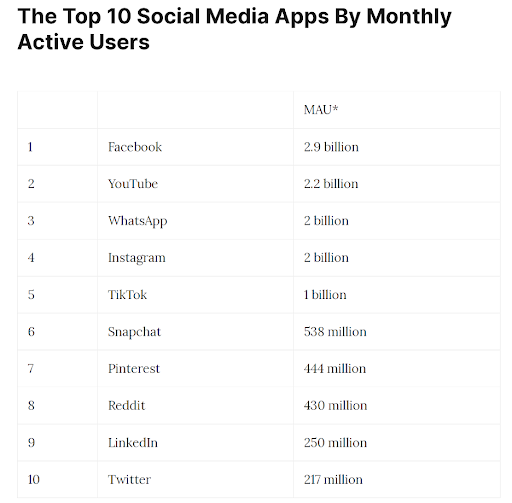Getting started with a paid social media strategy can be daunting and time-consuming.
As a social media advertising agency leader (say that three times fast), we often get clients asking if we can fix their existing campaigns to improve return on investment.
The problem?
They haven’t taken a step back to focus on an overall strategy.
They jumped into social advertising with an audience they thought was right, a platform they thought was right, and creative that they thought fit both this maybe-audience and maybe-platform.
Gathering data before creating ads is just as important as setting up and perfecting the ads themselves.
There are two primary data sets I recommend gathering to create an overall strategy:
- Understand the landscape of social media advertising.
- Understand your audience and how they relate to each social platform.
Once you understand the social media landscape and identify your ideal audience, you can create a social ads strategy with realistic goals that complement your SEO and other digital marketing efforts.
First: Understand The Landscape Of Social Advertising
Your target audience will not necessarily fall perfectly in line with the number of total social users. Still, some social networks have so many more active users that it may help sway you to include them in your strategy.
For example, if you know your target audience is on TikTok, start there.
Then, when it’s time to expand and test, you may want to consider Facebook because of the sheer number of users (and maybe you’ll learn something about a “new” target audience, after all).
Below is an insight from Search Engine Journal that lists the top 10 social advertising platforms and their monthly active users worldwide:

And here is another helpful chart that breaks down a few of the basics of the top social networks we’re seeing today.
Next: How To Get Started Crafting A Social Advertising Campaign
As discussed above, when getting ready to start social advertising, you don’t necessarily just want to choose Facebook, for example, because it has the most users.
On that same note, you don’t just want to assume your audience isn’t on Facebook because you think your target audience is younger.
The good news for advertisers is that each platform provides detailed audience insights that you can use to match your ideal audience without spending much money blindly testing. (More on this later.)
There are three major points, each with subsections, that matter when it comes to a paid strategy.
Audience Personas: Establishing Your Audience Demographics, Interests, And Behaviors
Audience personas give you an understanding of your ideal audience, including demographics, interests, and behaviors.
This step is always the first step for us, and there are a few different ways we gather this data:
Dig Into The Analytics
, to be exact.
The Audience section within Google Analytics is a great starting point since it has valuable insights that can guide your social advertising strategy.
It will show you who is currently interacting with your website, but more importantly, who is contributing to the conversions/transactions.
This data includes age, gender, location, and more.
For example, if you see that the age group of 18–24 is converting at a higher rate than 45–54, you may want to optimize your campaign for the younger age group.
Go To Where You Think Your Audience Is, And Interact
Believe it or not, some of our clients come to us with an idea for a social advertising campaign, but they aren’t actively engaging with their audience on that social network!
For example, it can take a while to build a presence.
So we always recommend building up your social media account first and getting out there to see what people are talking about – you may be surprised at what you learn.
Research Your Competitors
Observe where your competitors are active on social media and how they market their products or services.
This is an easy way to ensure you aren’t missing any opportunities and is usually a good starting point when beginning to craft a social advertising strategy.
You can learn more about how to.
Audience Segments: Understanding Where In The Customer Journey They Are (Awareness, Consideration, Conversion, Etc.)
Next, it’s essential to realize that while you may have one audience in terms of demographics, that audience can (and should) be further segmented down into where they are in the journey.
We usually segment an audience three times:
- Those who have never heard of your brand.
- Those who have engaged with your brand in the past, but only with blog posts or educational resources (which means they’re still learning).
- Those who are ready to buy, which is often shown by having items in a cart or having spoken to someone at your organization on the phone and expressed interest in buying.
While these three segments are general, you can think about your business specifically to come up with more defined segments that you may want to target, often called “audience personas.”
This is a big topic, so you can learn more about it.
Audience segmentation usually coincides with prospecting, retargeting, and remarketing campaigns (more resources on different campaign types later).
Audience Personalization: Developing Content And Messaging Specific To The Audience At The Proper Time In Their Journey
In short, there should be different content and messaging for someone who hasn’t heard of the company versus someone who has previously engaged with it.
Once you’ve defined your segments, it’s time to start personalizing content, and the type of content you write depends on the platform.
The next steps include:
- Match your audience with two or three platforms, and then expect to produce different ad creative based on your audience personas. By this point in your journey, you should have already analyzed the landscape of the social media options and researched where your audience is!
- Advertise on each of these platforms to see what works. You may only want to focus on one social platform, but we recommend at least two, as they can complement each other well. Also, since each platform has unique ad formats, we suggest creating ads specific to each channel while keeping the same look and feel for consistency.
- Refine your ads. Once again, this is a big topic. Tweaking your audience segmentations, your content, the time of day you post that content, etc., is an optimization skill all of its own. Keep in mind that you don’t want to make too many big changes without collecting enough data.
- Expand your strategy. Don’t be afraid to try other networks as you grow and refine your ads. You’ll start to see what’s working and what isn’t – and while this won’t be identical on every social network, you will start to get a baseline for where to begin your tests. This will help you save money and time in the long run as you expand.
Lastly: Setting Up Ad Campaigns
While this article focuses on the strategy for social advertising, being able to set up your ads successfully isn’t always as cut-and-dry as it should be because there are so many different campaign types.
Pro Tip: When setting up the campaigns, I recommend starting with three campaigns (prospecting, remarketing, and retargeting) to ensure you engage with your audience at the right time along their journey.
Below is an example to help get you started:
Prospecting (Awareness)
- Audience segment: Those who have never heard of your brand.
- Campaign objective: Reach, awareness.
- Messaging: Focus on the user. What problem are you trying to solve?
- Content types: Educational articles, industry news, research stories.
Retargeting (Consideration)
- Audience segment: Those who have engaged with your brand in the past, but only with your website, social media, or educational resource.
- Campaign objective: Engagement, clicks.
- Messaging: Focus on the benefits of using a product or service to solve the problem.
- Content types: Ebooks, whitepapers, company events.
Remarketing (Decision)
- Audience segment: Those who are ready to buy, which is often shown by having items in a cart or having spoken to someone at your organization.
- Campaign objective: Conversions, purchases.
- Messaging: Focus on why they should choose your solution to solve their problem versus your competitors.
- Content types: Testimonials, reviews, case studies.
Final Thoughts
Ultimately, creating an effective paid social media strategy will take time, and you will consistently be reiterating, revising, and optimizing.
As with anything, a successful business is about testing, but researching before jumping into paid media – and then using paid media as another part of your testing – is crucial for a successful overall strategy that complements your SEO and other digital marketing efforts.
Always define your goals, consider the engagement you want and expect, and then use the steps above to make it happen!







